11 Places NOT to Put Smoke Alarms – can you name them?
Home » Interior » Alarms: Smoke & CO »
The placement of smoke alarms is of paramount importance to ensure the safety of occupants within a home. When positioned correctly, smoke alarms can provide early detection of a fire, allowing residents adequate time to evacuate and potentially minimize property damage.

Fires can spread rapidly, and every second counts when it comes to evacuation. If a smoke alarm is placed too far from potential fire sources or in areas where smoke might not easily reach, it can delay the alarm’s activation, jeopardizing the safety of occupants. Additionally, proper placement reduces the likelihood of false alarms, which can lead to complacency and the dangerous practice of disabling the device.
Ultimately, strategically placing smoke alarms in recommended areas, such as on every level of a home and outside sleeping areas, maximizes their efficiency, ensuring that they serve their primary purpose of safeguarding lives and property.
When installing smoke alarms in a home, it’s equally crucial to know where not to place them to avoid false alarms and ensure optimal functionality.
Read our top 11 places to NOT install smoke alarms in your home
1. Bathrooms
Smoke alarms should not be installed in a bathroom because the steam from a hot shower or bath will often trigger the alarm. The moisture can also damage the alarm over time and cause it to fail. Therefore, do not put a smoke alarm in a bathroom or too close to a bathroom. Any smoke alarm that is within 20 feet of a bathroom should be the photoelectric type.

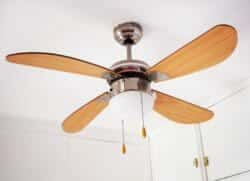
2. Near Fans
Do not place a smoke alarm closer than 3 feet in a horizontal path from the tip of the blade of a ceiling suspended (paddle) fan. The fan would tend to blow the smoke away from a smoke alarm if placed too close to the fan.
3. Near Vents, Supply Grills and Registers

Do not place smoke alarms closer than 3 feet from any furnace or A/C supply and return grills or registers. Do not place them in areas of turbulent air, where the airflow may prevent the smoke from reaching the alarms. Otherwise, do not put smoke alarms where the air blowing from vents can blow the smoke away from the smoke alarms.
4. Windows and sliding glass doors
Avoid locating a smoke alarm near openable windows where a draft may occur. Drafts from a window may actually blow smoke away from the alarm.
5. Within 4” of wall or ceiling corners – dead air space
Dead air space refers to areas within a room where air circulation is minimal or stagnant. In the context of smoke alarms, this term is particularly significant as these zones may prevent smoke from reaching the alarm promptly, thereby delaying its activation. Typically, dead air spaces are found at the apex of vaulted ceilings or in corners where walls and ceilings meet. Because warm air – and smoke – rises, it tends to not directly flow into these areas, instead getting trapped or circulating away.
When a smoke alarm is placed within a dead air space, its efficiency is compromised, as it may not detect a fire in its early stages. Understanding and avoiding such spaces in a home is crucial to ensuring that smoke alarms are placed in positions where they can provide the earliest possible warning of a fire.
6. Near Cooking appliances
Do not place close to cooking appliances, stoves and ovens. Smoke alarms should be installed at least 10 feet from a cooking appliance to minimize false alarms when cooking.

7. In Furnace and water heater closets
Do not put smoke alarms in gas fired furnace and gas fired water heater closets. This will help reduce nuisance tripping. Instead, use heat alarms in these locations.
8. Near laundry washing machines or dishwashers
Avoid placing smoke alarms near dishwashers or washing machines. Alarms should be installed at least 3 feet away from these appliances.
9. Garages
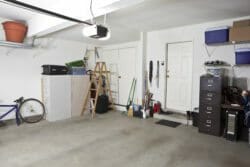
Do not place smoke alarms in a garage but do use a heat detector. It is recommended that smoke alarms be installed in rooms that have shared doors, walls or floors with the garage.
Note that garages are usually not heated or cooled, the actual temperatures in a garage may be above or below the temperature range that the alarm has been designed for. The smoke from cars exhaust fumes may also cause nuisance tripping or damage the sensors of the smoke alarm.
10. Unfinished Attic
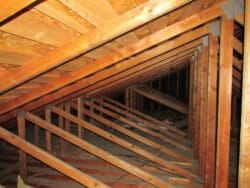
Smoke alarms are not designed to work in extreme heat or cold, or in areas where smoke and dust are common because they could damage the sensors of the alarm. Heat detectors should be used in attics.
11. Near fluorescent lights
Do not place smoke alarms closer than 1 foot from fluorescent lights as electrical “noise” and flickering may affect the alarm’s operation.
How big of an area will one smoke alarm cover?
Roughly 900 square foot is the maximum coverage for a smoke alarm. Beams, ceiling pockets, architectural design and a number of other factors determine the area a smoke alarm will actually cover.
Heat Alarms – what are they; where do they go?
Heat alarms are usually used in locations where smoke alarms may trip unnecessarily or falsely. They detect high heat from fires. Heat alarms can be situated in: the kitchens, gas furnace closets, gas water heater closets and in garages, because heat alarms don’t react to smoke and they are not prone to false alarms from cooking and exhaust fumes. They are inexpensive and are normally carried by Home Depot, Lowe’s and other home improvement stores.
Remember
- 10 year battery: all replacement smoke alarms should have a 10 year battery.
- Manufacture’s instructions – read and follow the instructions when installing a smoke alarm.
- Test all of your smoke alarms on a regular bases; per manufactures instructions.
- Replace old smoke alarms (if over 8 to 10 years old ), replace any damaged smoke alarms, and ones that have been painted over.
- If smoke alarms are inter-connected and you replace one, check that it is compatible with the other smoke alarms. At times smoke alarms from different manufactures or older models will not function properly with a new smoke alarm; it may fail or some may not sound.
The time to escape a house fire today is MUCH LESS
30 years ago the average time to escape a house fire was about 17 minutes. Now it’s about 4 or 5 minutes.

More homes have smoke alarms and carbon monoxide detectors than ever before, yet escape times have dropped tremendously. The smoke in home fires now has more poisonous gases in it and the fires burn much hotter.
Breathing the smoke in house fires today can quickly damage your lungs and cause you to pass out.
Families really need to understand what has happened over the last 30 years to make the fires more dangerous and what they need to do.
(Read what to do in a house fire that can save your life)

The Bottom Line
You wouldn’t put your seat belt around your neck or install a baby car seat backwards because of the risk of serious injuries. The same is true if you install a smoke alarm in the wrong place. It is also important to remember that that codes may differ somewhat from one building jurisdiction to another.
Be safe. Check your own smoke alarms and advise your friends, clients and neighbors.
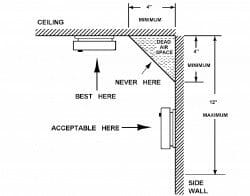
Where Are Smoke Alarms Required? Sellers and Buyers Want to Know
Roughly two-thirds (62%) of reported home fire deaths resulted from fires in homes with no smoke alarms or no working smoke alarms. Smoke alarms are inexpensive and save lives.
Know what rooms and where to put them. Read more
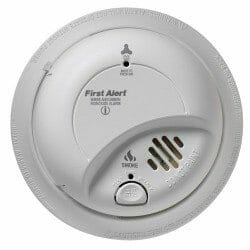
Where Are Carbon Monoxide Detectors Required ?
Carbon monoxide (CO) is a tasteless, colorless, odorless, and poisonous gas produced by burning fossil fuels, such as natural gas, propane, wood, etc. It is very deadly and every home should have them in the proper places. Read more



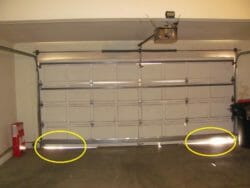
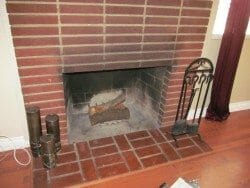
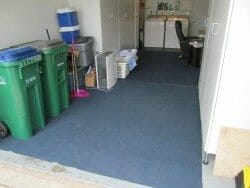

what kind of heat detector can be installed in the bathroom with water heater in a remote area (gas well-rig less site)
question, can you set a smoke detector on a ledge?
Can detectors be placed on the wall above a doorway